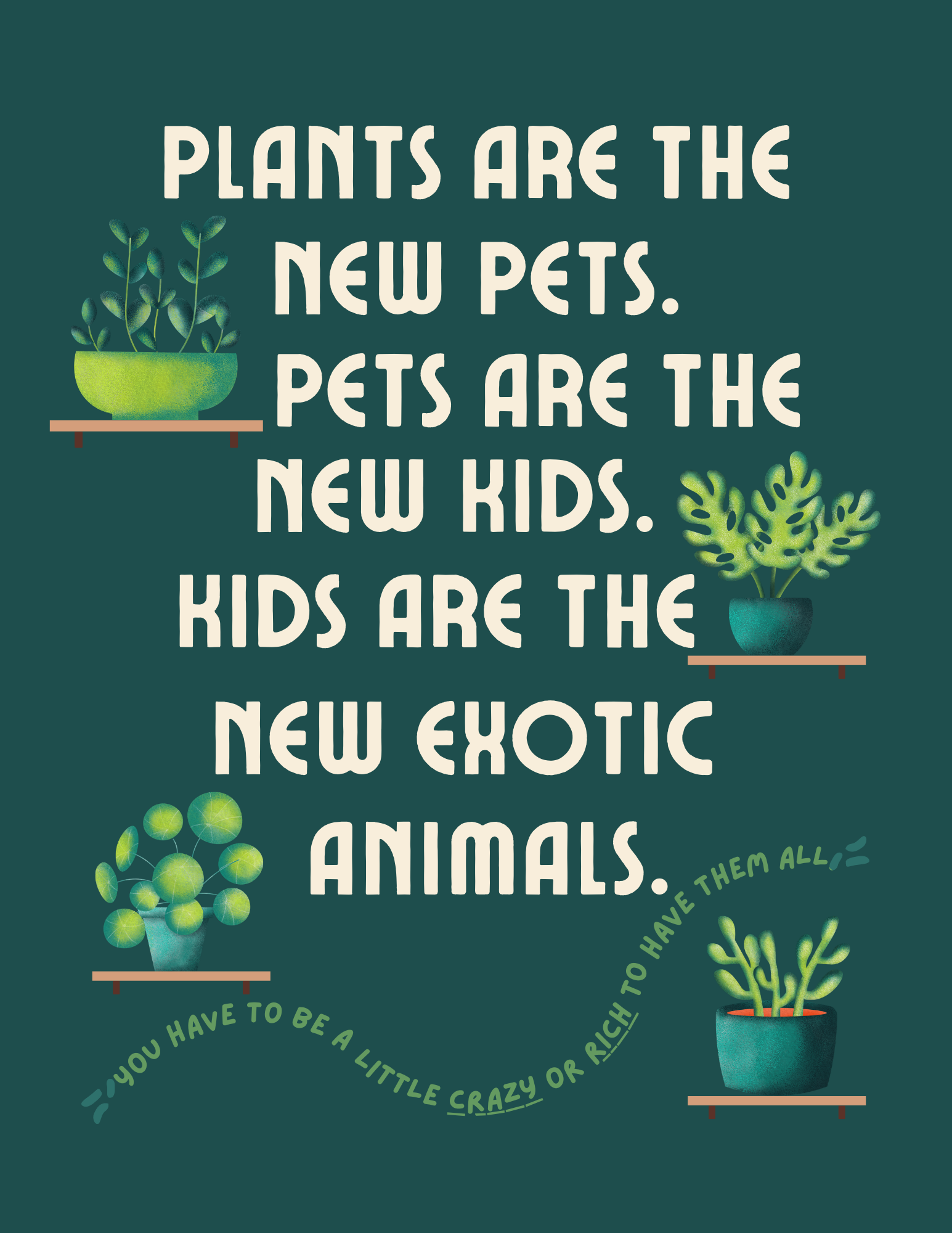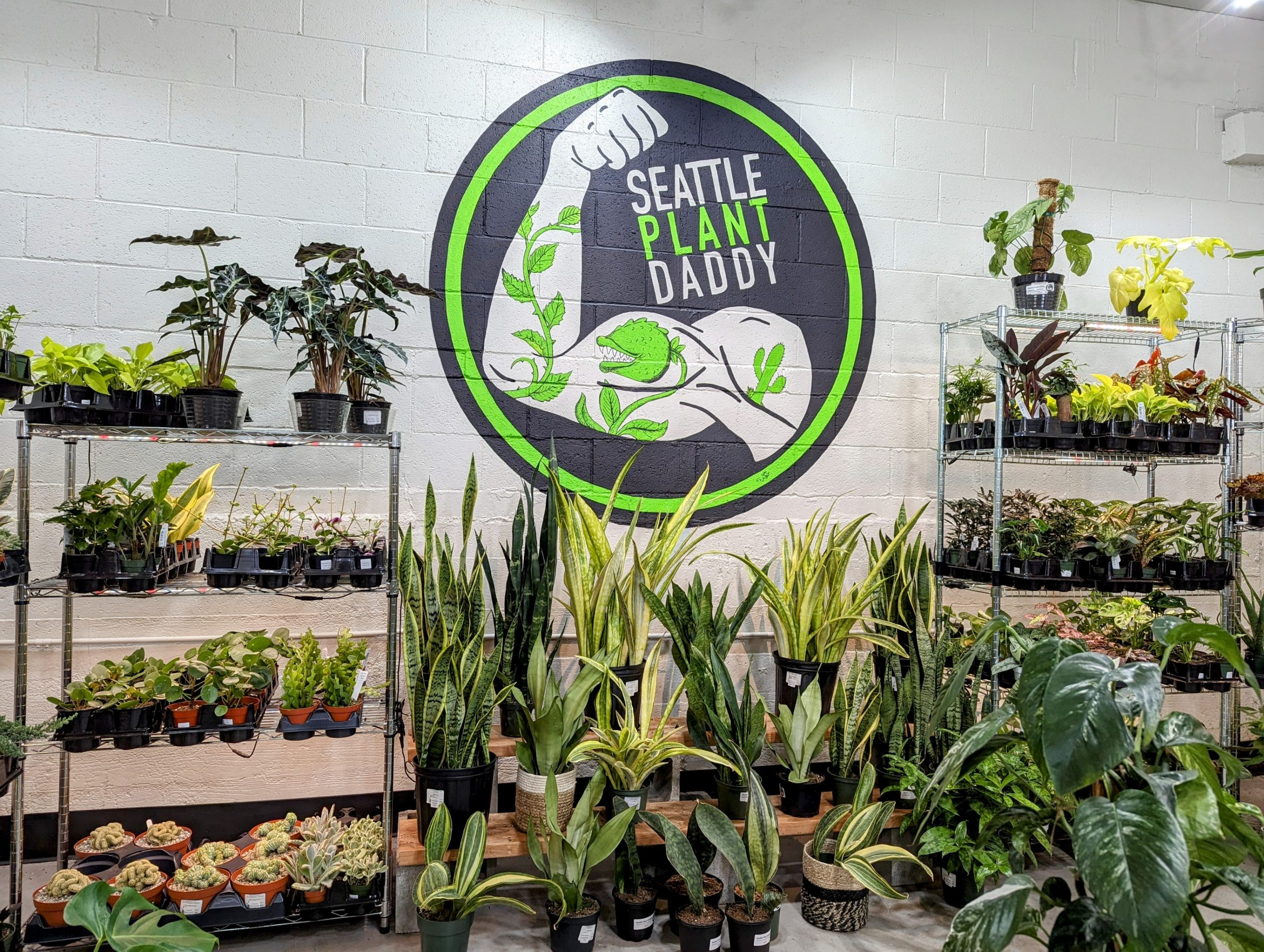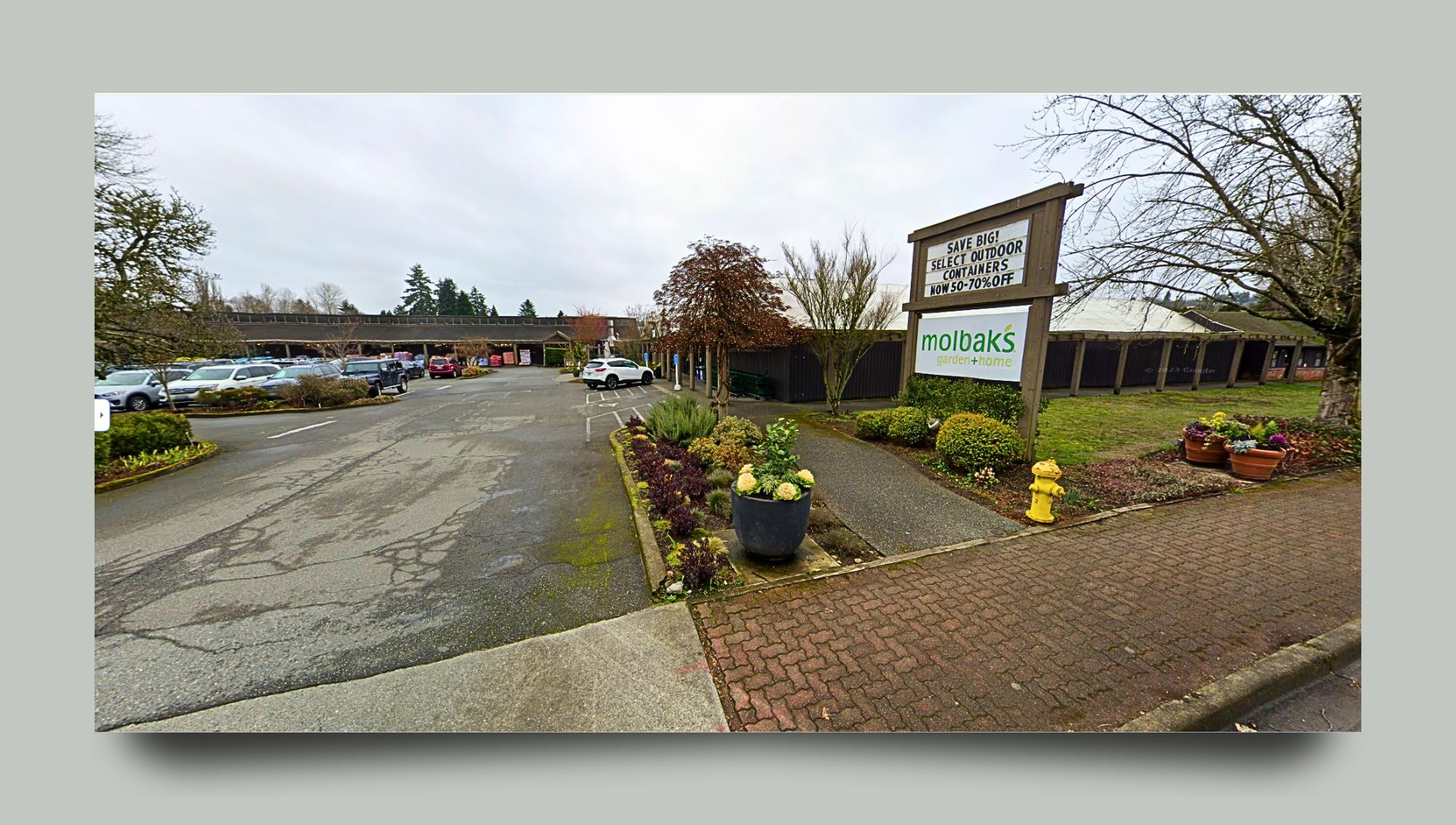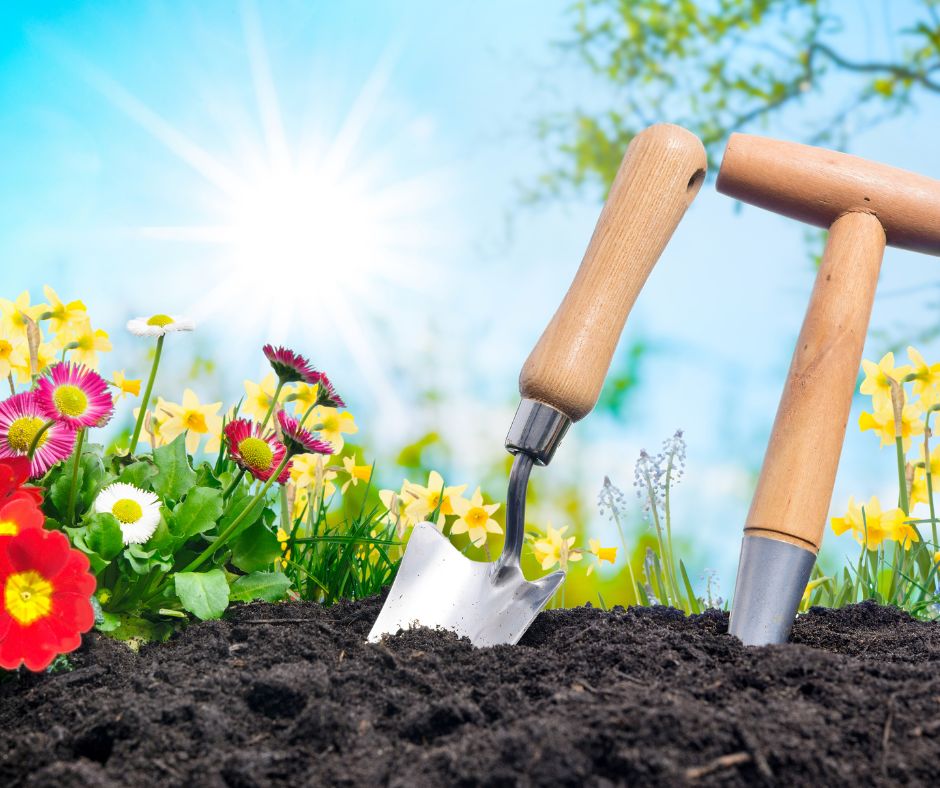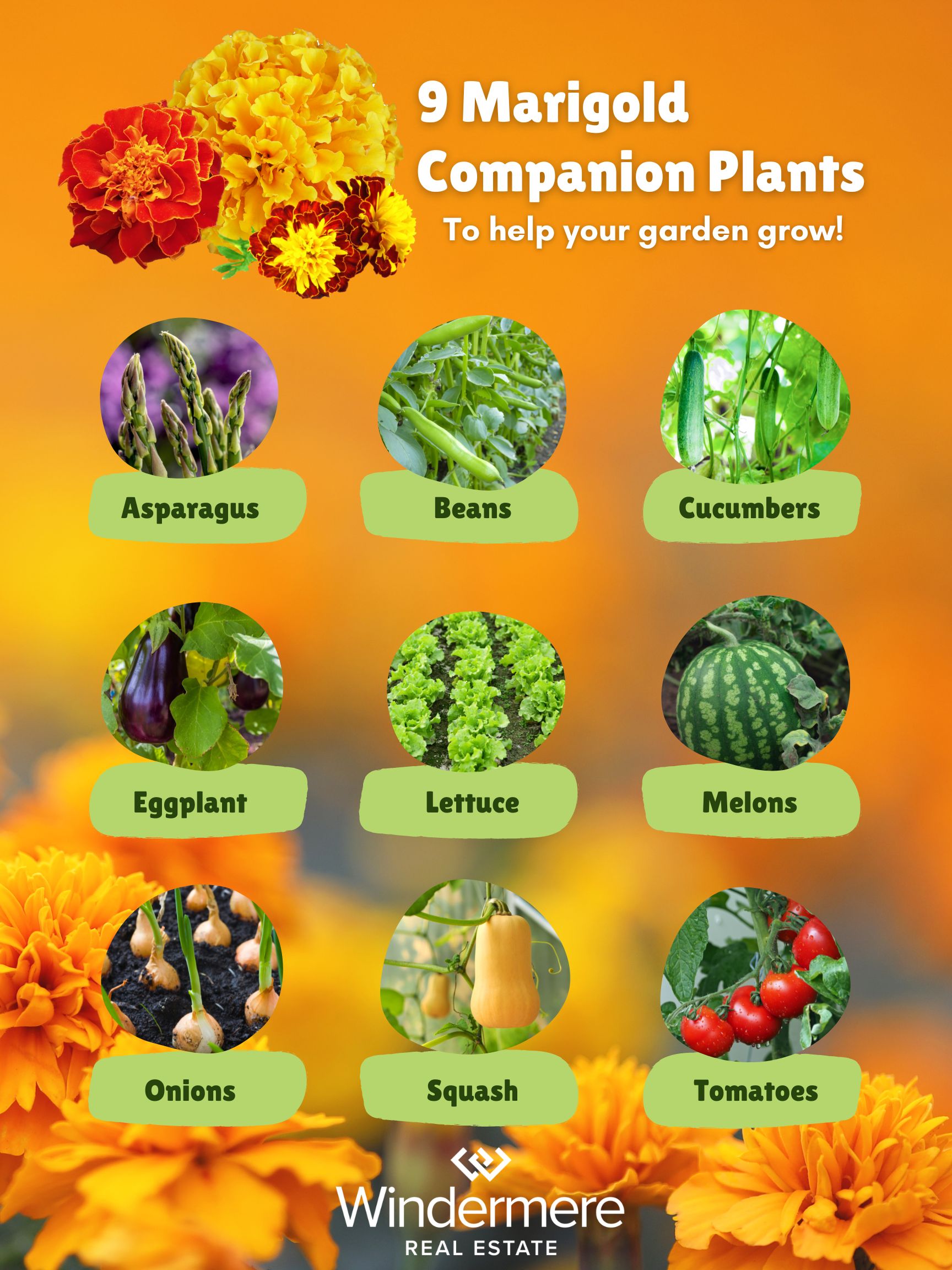Houseplants
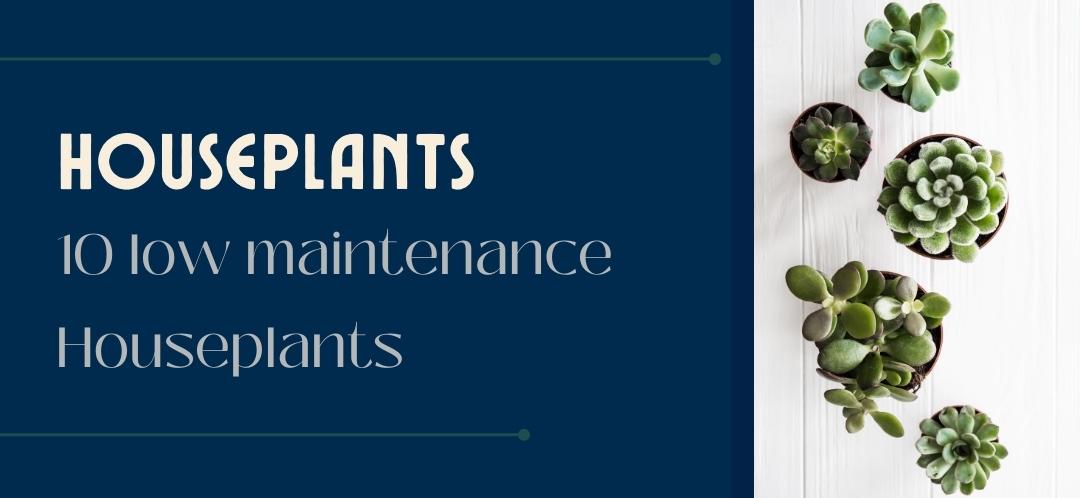
The Rise of Houseplants
Have you heard that houseplants are the new pets and pets are the new children? The popularity of houseplants grew substantially during the pandemic when people were isolated and looking to make connections with any living thing. Luckily, unlike some quick unions, embracing these leafy companions came with many benefits.
Here are some of the most significant benefits of having houseplants in your home:
- Air purification: A study by NASA showed indoor plants improve air quality by removing harmful chemicals from the air.
- Improved mood: Studies have also shown that house plants can improve your mood and reduce feelings of anxiety, depression, and stress.
- Increased Productivity: A study by WSU concluded that live indoor plants can help to increase productivity by 12%, making them great additions to home offices and workspaces.
- Self Care: Some plants, such as Aloe Vera, have healing properties when harnessed correctly. I would strongly advise you to do your research before adding plant remedies to your list of health fixes though. Because on the other hand, some plants can cause you harm.
- Aesthetics: I feel like this is the most obvious benefit of having house plants in your home. They are a good means of adding natural beauty to your space!
Now, if you’re new to the houseplant scene or have a track record of killing all things green, fear not. There are plenty of low maintenance options available, perfectly suited to your level of expertise. Let’s explore a few.
10 Houseplants That Are Low Maintenance
Spider Plant
Speaking from personal experience I can say, Spider plants are incredibly resilient and can thrive in various lighting conditions, from low to indirect bright light. They should be kept in well-draining soil and watered when the soil feels lightly dry to a finger probe. AND Bonus: they’re non-toxic! Mine has survived being the first plant of an inexperienced tween-aged handler, endured an attack from a poorly aimed dog toy, and a fall from a short height. The only thing it doesn’t tolerate is tap water with high chlorine levels, which causes the tips of its leaves to turn brown. To solve this, simply let your tap water sit for a few days before using it to hydrate your plant.
Snake Plant
I feel like these plants are everywhere, and for good reason too. The Snake Plant is an excellent choice for beginners. It can withstand drought-like conditions and adapt to various lighting situations. Plant it in well-draining soil, such as a cactus mix, and water it when the soil is dry to the touch. This plant is another one that owners find great success propagating. Just be aware this plant is toxic, so keep it away from curious fur babies, babies, and foolish adults.
Holiday Cactus (Thanksgiving, Christmas, Easter)
If you’re seeking vibrant floral colors, the Holiday Cactus is the perfect choice. I currently have a Thanksgiving and a Christmas Cactus in my home. I must admit that I have not perfected the art of getting them to rebloom annually; mine seem to prefer every other year. They are non-toxic though.
Pothos
Ah, the Pothos plant. These plants are widely available and incredibly easy to care for. I had the pleasure of nursing some Pothos plants in our office back to health that were struggling from the aftermath of the 2020 work from home order. With very little TLC they bounced right back to life before they disappeared under mysterious circumstances a few months ago. But I digress. Pothos thrive in low to bright indirect light and require minimal maintenance. With 15 species to choose from, you can find a leaf pattern and color that perfectly suits your style. You can let them hang loose, or vine. Just be aware that Pothos plants are toxic.
Air Plants
Air plants defy the traditional norms of plant care. Unlike their soil-bound counterparts, air plants require no soil. This unique feature allows for creative displays, such as hanging terrariums or natural wood features. These plants draw moisture from the air, but they still need occasional watering. Mist your air plant weekly and give it a good soak every now and again, adjusting the care based on the humidity levels in your home. If you notice it wilting, it’s a good sign it’s time to dunk it. The best part? Air plants are non-toxic.
Pilea
The Pilea Pepermoides, also known as the Money Plant or UFO Plant, is a standout with its flat pad-like leaves. It thrives in medium to bright indirect light, but direct sunlight can lead to leaf burn. Keep an eye on the leaves, and when they start to droop slightly, it’s time for watering. This plant is non-toxic.
Haworthia
Resembling an Aloe Vera plant, the Haworthia earns its nickname, the Zebra plant, from the striking white stripes that run the length of its spiked leaves. This succulent requires bright indirect sunlight and thrives when you allow the soil to dry before watering. It’s a low maintenance plant that is also non-toxic.
Lucky Bamboo
If you’re looking for an almost indestructible plant, Lucky Bamboo is your best bet. It can grow in water or soil, tolerates low light, and thrives in bright to medium indirect sunlight. With its unique shapes and versatility in pot choices, it is customizable to any space. I was surprised to find out that Lucky Bamboo isn’t bamboo at all; it’s related to the water lily. And unfortunately, it is toxic.
ZZ Plant
The ZZ Plant is a true low-maintenance champion. It can tolerate low light conditions and infrequent watering, making it the perfect fit for forgetful plant parents. Planted in well-draining soil, this resilient plant can survive in several different conditions. I know this because I sometimes forget about the one sitting outside of our office entrance. Just be aware that this plant is toxic. Moreover, it can cause allergic reactions to its handler’s skin, much like poison ivy. So, handle it with caution and care.
Herbs
Finally, let’s not forget about the sustainable option of growing herbs in your home. You’ll not only save on grocery bills but also have fresh ingredients readily available. Many herbs can be grown from scraps and cuttings- from green onions to basil you have a lot of options to choose from. And of course, herbs are non-toxic for human consumption.
Houseplants Are Addicting
In conclusion, houseplants offer a plethora of benefits, ranging from air purification and aesthetics to mental well-being and increased productivity. They’re the perfect companions for any home, regardless of your gardening experience. Just remember to do your research, especially if you have pets or young children, as many common houseplants are toxic if ingested.
And one last word of caution before you go. It’s easy to become addicted once you develop a green thumb. Trust me, I’ve been there. One minute I was content with a $4 Lucky Bamboo plant, and next thing I knew, I stood eyeing that beautiful White Princess Philodendron at Seattle Plant Daddy, contemplating if I was experienced enough to handle the splurge. It’s a slippery slope, but a rewarding one.
Happy Planting!
Kerriann Jenkins
Molbak’s Garden + Home
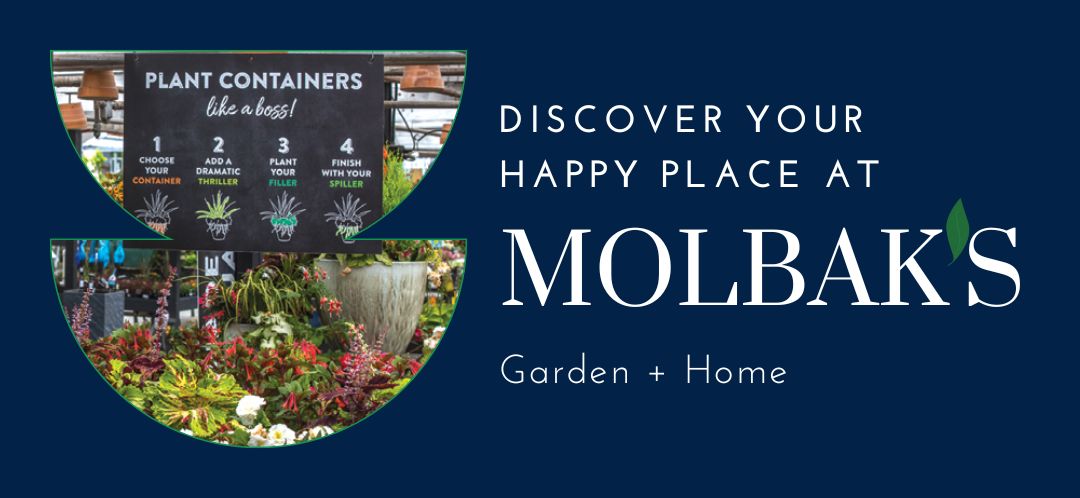
Molbak‘s Garden + Home
Have you ever driven past Molbak’s and wondered what was inside? I had passed the store a handful of times on my way to other places and never thought to stop in and check it out. All that changed once I discovered the hidden oasis that awaits inside its unassuming exterior. Let me tell you, you don’t have to be a plant lover to enjoy Molbak’s because Molbak’s Garden + Home offers more than just plants and it is dog friendly too!
A Sanctuary Full of Treasures
As soon as you step through the main entrance, you’ll be transported into a sanctuary full of treasures. Molbak’s offers an assortment of hard-to-resist wares. Looking to personalize your space? Molbak’s has eco-conscious kitchen goods and home décor items that will make your space feel unique. Need to de-stress? They have wellness products like essential oils and body lotions that will help you relax. Looking for a special gift? They have artisan-crafted jewelry and cozy apparel too. They even have patio furniture!
Molbak’s Garden Café
But that’s not all. Just when you think you’ve seen everything, the indoor section leads you to another hidden treasure. Nestled between the indoor section and the greenhouses is Molbak’s Garden Café. The café is inside a jungle of plants, which almost makes you forget that you’re in the heart of a bustling store. I have not eaten there yet so I will have to save that review for another time. But I did peak my head in to marvel at the floor to ceiling plants. They are stunning.
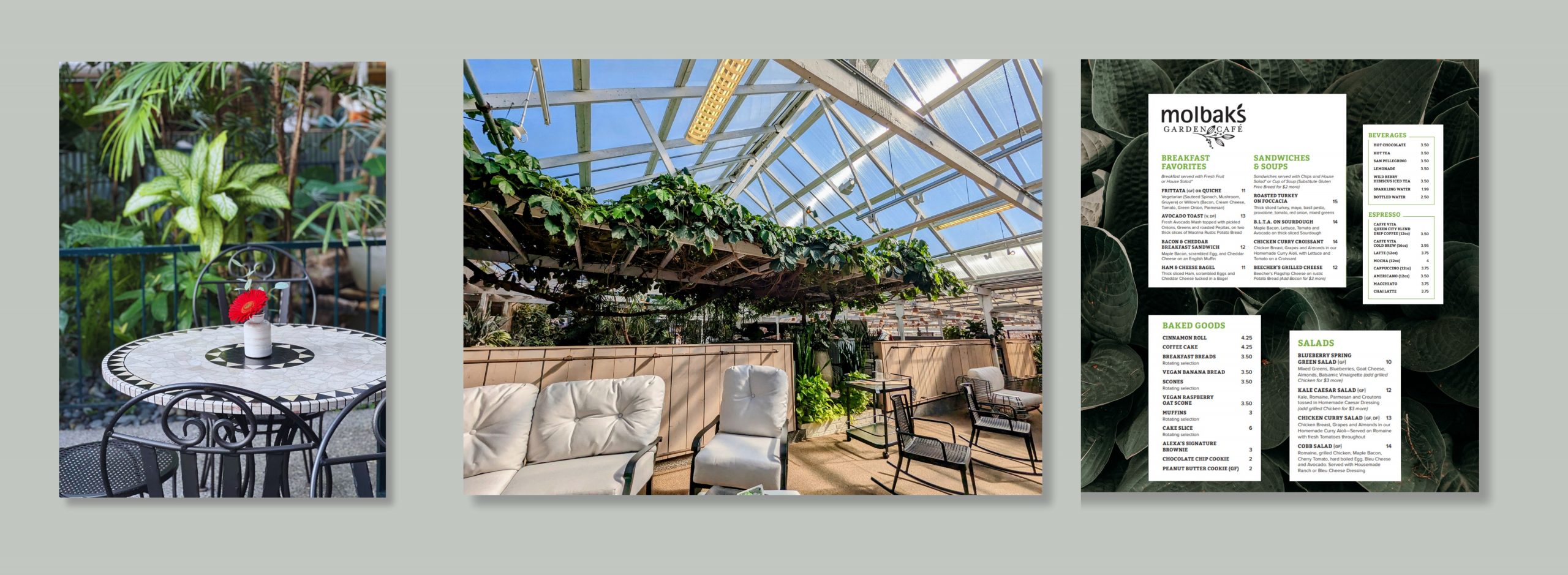
Click to link to current menu and pricing. Credit: 1st & 3rd image Molbak’s Garden Cafe, 2nd Image I captured last time I visited.
Molbak’s Garden + Home Greenhouses
Beyond the café are the greenhouses, which in my opinion, are the real star of Molbak’s. As soon as you step into the greenhouse section, you’ll feel like you fell down the rabbit hole into a Wonderland of greenery. You’ll be surrounded by rows and rows of plants including tropical varieties, succulents, herbs, and flowers. If you’re a plant lover like me, you’ll be in heaven here. I’ve spent hours wandering through their greenhouses, admiring the vibrant colors and unique textures of each of their hundreds of plants.
The Featured Displays Will Draw You In
The great thing about Molbak’s is that they’re masters at creating impactful feature displays that will draw you in. They have these meticulously curated tables that are so fun to explore. The last time I was there, they had a table of finely crafted DIY terrariums that caught my eye, followed by a vibrant display of carnivorous plants. I particularly enjoyed looking at the various hypnotic but ominous pitcher plant varieties.
Prepare To Experience The Greenhouse Effect During Your Visit
It is easy to lose track of time in the store. So when you visit Molbak’s, you should prepare yourself for a warm stroll because the greenhouses stay warm inside. Even during the winter. On my last visit the cups at the water dispenser had run out so I found myself wishing I had packed a water bottle. Apart from that, I generally enjoy the warmth of the greenhouse air wrapped around me like a warm hug. But learn from my mistake and pack a water bottle!
The Outdoor Section
After making your way through all of the greenhouses, yes I said greenhouses, because there are multiple greenhouse rooms at Molbak’s; you will enter the outdoor section. Here you will find garden tools, plants, pots and more. Since it is Native plant appreciation month, I would be remiss not to point out that they even feature a whole section of Native plant species for sale!
Molbak’s Butterfly Garden at Woodland Park Zoo
But that’s not all! Molbak’s Garden + Home is more than just a store, it’s a community hub. They hold events and classes, so they have spaces reserved for that. They even sponsor Molbak’s Butterfly Garden at Woodland Park Zoo, which focuses on the life cycle and identification of North America’s butterflies and on the preservation and restoration of native plant habitats for these pollinators.

Click to link to Woodland Park Zoo’s Website to find out more information about Molbak’s Butterfly Garden
Molbak’s Garden + Home & The Gardens District
And guess what? Molbak’s has big plans in the works for expansion! They’re breaking ground in 2023 on what will become The Gardens District. As summarized from the information on the project’s home page, The Gardens District will become the new home for Molbak’s Garden + Home and house a hotel, residential living, and native plant gardens, all of which will promote sustainable living.
Come Find Your New Happy Place
As you can see, while Molbak’s may look unassuming from the outside, it’s an oasis for growth, both for the plants and wares it houses inside, as well as the community of Woodinville. But I can sum its existence up into one phrase. I just call it my Happy Place.
by Kerriann Jenkins
Companion Planting
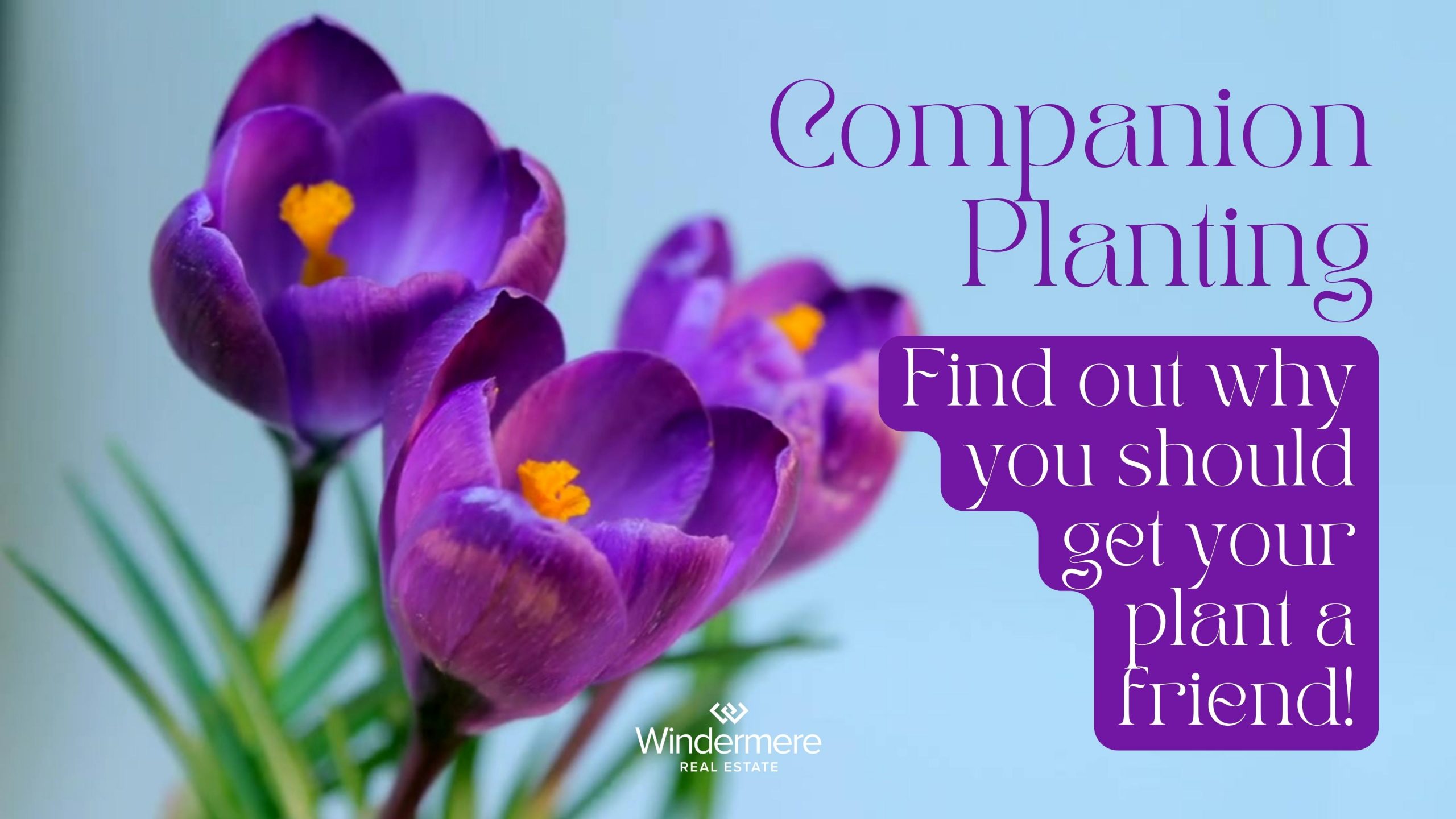
Companion Planting
Did you know that your garden plants can benefit from having a friend planted beside them? Companion planting is a great way to improve the health and yield of your garden. By planting certain crops together, you can create a mutually beneficial environment that promotes growth and deters pests. Moreover, creating biodiversity in your garden can have a visually pleasing affect for you to enjoy. Here are some tips for companion planting:
- Do you research and grow complementary plants beside one another. Some plants have properties that will naturally repel pests and others will attract them. Use this knowledge to your advantage and try pairing the two together to repel any unwanted visitors.
- Choose your plant friends wisely. Boundaries and needs matter, even in the plant world. You should take into consideration the ground coverage, spacing, sunlight and watering requirements of your plant before giving it a buddy. You want to make sure that both plants receive the right amount of sunlight, water, air circulation, spacing and nutrients that they need to grow big and strong.
- Companion planting is an art, not an exact science. Don’t be afraid to mix things up and see what works best in your garden. Keep track of what works well and change what doesn’t. Over time you will refine a planting strategy that gives you a beautiful, diverse, and enriched garden.
Putting Companion Planting to the Test
Using the companion planting technique, let’s examine the benefits of planting marigolds in your garden. Marigolds have gained a reputation for being great companion plants because they have many benefits for plants growing near them. Equally as important, they remain neutral toward plants who do not receive benefits from growing near them.
Here are some things to consider before adding Marigolds to your garden:
- Marigolds are a highly fragrant flower and because of that they are known to deter garden destroying pests such as mosquitoes, who nibble on you, and nematodes, who cause root rot.
- There are good bugs in gardens too. Marigolds attract beneficial bugs like pollinators, who will help make your garden grow, and ladybugs, who kill aphids.
- Marigolds grow in a variety of sizes and their size should be considered when selecting a perfect pairing.
- French Marigolds for example grow great near tomato plants. They are a shorter variety and are not overpowered by tall tomato vines. They bloom in spring and can last until the ground frosts, and they hold up well in the rainy PNW environment.
- African Marigolds grow much taller and have blooms measuring up to 4 inches in size, which could put new growth around them in constant shadow. But they are visually impactful and would be a great addition to a garden backdrop or as ground cover for tall plants like sunflowers.
Marigolds are a great option when companion planting:
Bonus Tip: Use Native Plants
Adding native plants to your companion planting choices is a great idea. These plants are naturally strong and adapted to their environment. This means they can grow well without much attention from you! Additionally, they need less water and fertilizer compared to non-native varieties. Native plants also attract local animals that can help take care of your garden, like natural pollinators. If you want to learn more about using native plants for companion planting, I suggest you check out this study by David James of WSU.
Symbiotic Relationships Will Strengthen Your Garden Growth!
Remember, companion planting is all about finding the right balance that will benefit the plants you plot next to each other. There are countless combinations of plants that can be successfully grown together, making companion planting a fun and creative way to optimize your garden. Give it a try and see the difference companion plants make in your garden!

 Facebook
Facebook
 X
X
 Pinterest
Pinterest
 Copy Link
Copy Link
